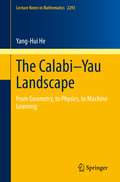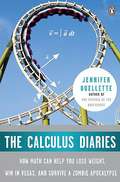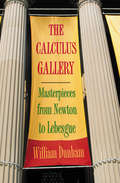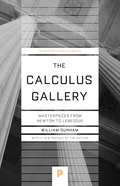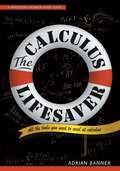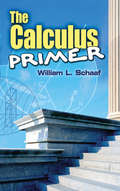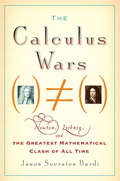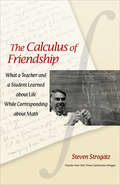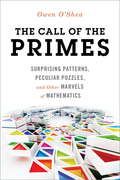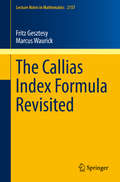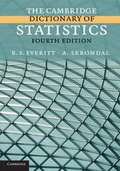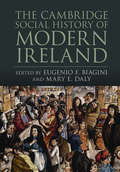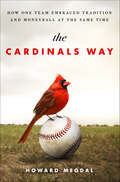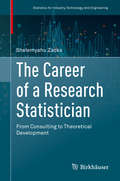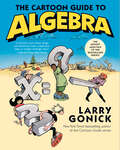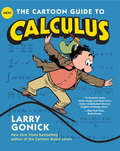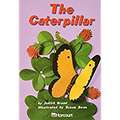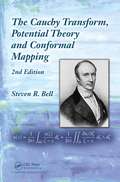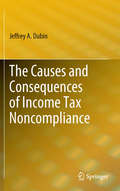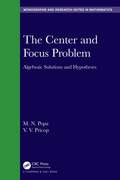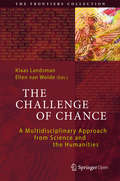- Table View
- List View
The Calabi–Yau Landscape: From Geometry, to Physics, to Machine Learning (Lecture Notes in Mathematics #2293)
by Yang-Hui HeCan artificial intelligence learn mathematics? The question is at the heart of this original monograph bringing together theoretical physics, modern geometry, and data science. The study of Calabi–Yau manifolds lies at an exciting intersection between physics and mathematics. Recently, there has been much activity in applying machine learning to solve otherwise intractable problems, to conjecture new formulae, or to understand the underlying structure of mathematics. In this book, insights from string and quantum field theory are combined with powerful techniques from complex and algebraic geometry, then translated into algorithms with the ultimate aim of deriving new information about Calabi–Yau manifolds. While the motivation comes from mathematical physics, the techniques are purely mathematical and the theme is that of explicit calculations. The reader is guided through the theory and provided with explicit computer code in standard software such as SageMath, Python and Mathematica to gain hands-on experience in applications of artificial intelligence to geometry. Driven by data and written in an informal style, The Calabi–Yau Landscape makes cutting-edge topics in mathematical physics, geometry and machine learning readily accessible to graduate students and beyond. The overriding ambition is to introduce some modern mathematics to the physicist, some modern physics to the mathematician, and machine learning to both.
The Calculus Diaries: How Math Can Help You Lose Weight, Win in Vegas, and Survive a Zombie Apocalypse
by Jennifer OuelletteThe Calculus Diaries is the fun and fascinating account of her year spent confronting her number-phobia head on. With real wit and verve, Ouellette shows how she learned to apply calculus to everything from petrol mileages to dieting, from rollercoaster rides to shooting cards in Las Vegas - proving that anyone can learn the fundamentals of maths' universal language, and make the world a whole lot more comprehensible.
The Calculus Gallery
by William DunhamMore than three centuries after its creation, calculus remains a dazzling intellectual achievement and the gateway into higher mathematics. This book charts its growth and development by sampling from the work of some of its foremost practitioners, beginning with Isaac Newton and Gottfried Wilhelm Leibniz in the late seventeenth century and continuing to Henri Lebesgue at the dawn of the twentieth--mathematicians whose achievements are comparable to those of Bach in music or Shakespeare in literature. William Dunham lucidly presents the definitions, theorems, and proofs. "Students of literature read Shakespeare; students of music listen to Bach," he writes. But this tradition of studying the major works of the "masters" is, if not wholly absent, certainly uncommon in mathematics. This book seeks to redress that situation. Like a great museum, The Calculus Gallery is filled with masterpieces, among which are Bernoulli's early attack upon the harmonic series (1689), Euler's brilliant approximation of pi (1779), Cauchy's classic proof of the fundamental theorem of calculus (1823), Weierstrass's mind-boggling counterexample (1872), and Baire's original "category theorem" (1899). Collectively, these selections document the evolution of calculus from a powerful but logically chaotic subject into one whose foundations are thorough, rigorous, and unflinching--a story of genius triumphing over some of the toughest, most subtle problems imaginable. Anyone who has studied and enjoyed calculus will discover in these pages the sheer excitement each mathematician must have felt when pushing into the unknown. In touring The Calculus Gallery, we can see how it all came to be.
The Calculus Gallery: Masterpieces from Newton to Lebesgue (Princeton Science Library #60)
by William DunhamMore than three centuries after its creation, calculus remains a dazzling intellectual achievement and the gateway to higher mathematics. This book charts its growth and development by sampling from the work of some of its foremost practitioners, beginning with Isaac Newton and Gottfried Wilhelm Leibniz in the late seventeenth century and continuing to Henri Lebesgue at the dawn of the twentieth. Now with a new preface by the author, this book documents the evolution of calculus from a powerful but logically chaotic subject into one whose foundations are thorough, rigorous, and unflinching—a story of genius triumphing over some of the toughest, subtlest problems imaginable. In touring The Calculus Gallery, we can see how it all came to be.
The Calculus Lifesaver
by Adrian BannerFor many students, calculus can be the most mystifying and frustrating course they will ever take. The Calculus Lifesaverprovides students with the essential tools they need not only to learn calculus, but to excel at it. All of the material in this user-friendly study guide has been proven to get results. The book arose from Adrian Banner's popular calculus review course at Princeton University, which he developed especially for students who are motivated to earn A's but get only average grades on exams. The complete course will be available for free on the Web in a series of videotaped lectures. This study guide works as a supplement to any single-variable calculus course or textbook. Coupled with a selection of exercises, the book can also be used as a textbook in its own right. The style is informal, non-intimidating, and even entertaining, without sacrificing comprehensiveness. The author elaborates standard course material with scores of detailed examples that treat the reader to an "inner monologue"--the train of thought students should be following in order to solve the problem--providing the necessary reasoning as well as the solution. The book's emphasis is on building problem-solving skills. Examples range from easy to difficult and illustrate the in-depth presentation of theory. The Calculus Lifesavercombines ease of use and readability with the depth of content and mathematical rigor of the best calculus textbooks. It is an indispensable volume for any student seeking to master calculus. Serves as a companion to any single-variable calculus textbook Informal, entertaining, and not intimidating Informative videos that follow the book--a full forty-eight hours of Banner's Princeton calculus-review course--will be available through the book's Web site at www. calclifesaver. com More than 475 examples (ranging from easy to hard) provide step-by-step reasoning Theorems and methods justified and connections made to actual practice Difficult topics such as improper integrals and infinite series covered in detail Tried and tested by students taking freshman calculus
The Calculus Primer
by William L. SchaafComprehensive but concise, this introduction to differential and integral calculus covers all the topics usually included in a first course. The straightforward development places less emphasis on mathematical rigor, and the informal manner of presentation sets students at ease. Many carefully worked-out examples illuminate the text, in addition to numerous diagrams, problems, and answers.Bearing the needs of beginners constantly in mind, the treatment covers all the basic concepts of calculus: functions, derivatives, differentiation of algebraic and transcendental functions, partial differentiation, indeterminate forms, general and special methods of integration, the definite integral, partial integration, and other fundamentals. Ample exercises permit students to test their grasp of subjects before moving forward, making this volume appropriate not only for classroom use but also for review and home study.
The Calculus Wars: Newton, Leibniz, and the Greatest Mathematical Clash of All Time
by Jason Socrates BardiThis vibrant and gripping history ultimately exposes how these twin mathematical giants (Newton, Leibniz) were proud, brilliant, at times mad, and in the end completely human.
The Calculus of Friendship: What a Teacher and a Student Learned about Life while Corresponding about Math
by Steven StrogatzThe Calculus of Friendship is the story of an extraordinary connection between a teacher and a student, as chronicled through more than thirty years of letters between them. What makes their relationship unique is that it is based almost entirely on a shared love of calculus. For them, calculus is more than a branch of mathematics; it is a game they love playing together, a constant when all else is in flux. The teacher goes from the prime of his career to retirement, competes in whitewater kayaking at the international level, and loses a son. The student matures from high school math whiz to Ivy League professor, suffers the sudden death of a parent, and blunders into a marriage destined to fail. Yet through it all they take refuge in the haven of calculus--until a day comes when calculus is no longer enough. Like calculus itself, The Calculus of Friendship is an exploration of change. It's about the transformation that takes place in a student's heart, as he and his teacher reverse roles, as they age, as they are buffeted by life itself. Written by a renowned teacher and communicator of mathematics, The Calculus of Friendship is warm, intimate, and deeply moving. The most inspiring ideas of calculus, differential equations, and chaos theory are explained through metaphors, images, and anecdotes in a way that all readers will find beautiful, and even poignant. Math enthusiasts, from high school students to professionals, will delight in the offbeat problems and lucid explanations in the letters. For anyone whose life has been changed by a mentor, The Calculus of Friendship will be an unforgettable journey.
The Call of the Primes: Surprising Patterns, Peculiar Puzzles, and Other Marvels of Mathematics
by Owen O'SheaThis sampler of entertaining mathematical diversions reveals the elegance and extraordinary usefulness of mathematics for readers who think they have no aptitude for the subject.<P><P> If you like any kind of game at all, you’ll enjoy the amazing mathematical puzzles and patterns presented here in straightforward terms that any layperson can understand. From magic squares and the mysterious qualities of prime numbers to Pythagorean triples, probability theory, the Fibonacci sequence, and more, the author shows that math can be fun while having some profound implications. <P> Such ubiquitous mathematical entities as pi and the Fibonacci numbers are found throughout the natural world and are also the foundation of our technological civilization. By exploring the intriguing games presented here, you’ll come away with a greater appreciation for the beauty and importance of these and many more math concepts. <P> This is the perfect book for people who were turned off by math in school but now as adults wonder what they may have missed.
The Callias Index Formula Revisited
by Fritz Gesztesy Marcus WaurickThese lecture notes aim at providing a purely analytical and accessible proof of the Callias index formula. In various branches of mathematics (particularly, linear and nonlinear partial differential operators, singular integral operators, etc. ) and theoretical physics (e. g. , nonrelativistic and relativistic quantum mechanics, condensed matter physics, and quantum field theory), there is much interest in computing Fredholm indices of certain linear partial differential operators. In the late 1970's, Constantine Callias found a formula for the Fredholm index of a particular first-order differential operator (intimately connected to a supersymmetric Dirac-type operator) additively perturbed by a potential, shedding additional light on the Fedosov-Hörmander Index Theorem. As a byproduct of our proof we also offer a glimpse at special non-Fredholm situations employing a generalized Witten index.
The Cambridge Dictionary of Statistics
by B. S. Everitt A. SkrondalIf you work with data and need easy access to clear, reliable definitions and explanations of modern statistical and statistics-related concepts, then look no further than this dictionary. Nearly 4000 terms are defined, covering medical, survey, theoretical, and applied statistics, including computational and graphical aspects. Entries are provided for standard and specialized statistical software. In addition, short biographies of over 100 important statisticians are given. Definitions provide enough mathematical detail to clarify concepts and give standard formula when these are helpful. The majority of definitions then give a reference to a book or article where the user can seek further or more specialized information, and many are accompanied by graphical material to aid understanding.
The Cambridge Social History of Modern Ireland
by Mary E. Daly Biagini Eugenio F.Covering three centuries of unprecedented demographic and economic changes, this textbook is an authoritative and comprehensive view of the shaping of Irish society, at home and abroad, from the famine of 1740 to the present day. The first major work on the history of modern Ireland to adopt a social history perspective, it focuses on the experiences and agency of Irish men, women and children, Catholics and Protestants, and in the North, South and the diaspora. An international team of leading scholars survey key changes in population, the economy, occupations, property ownership, class and migration, and also consider the interaction of the individual and the state through welfare, education, crime and policing. Drawing on a wide range of disciplinary approaches and consistently setting Irish developments in a wider European and global context, this is an invaluable resource for courses on modern Irish history and Irish studies.
The Canterbury Puzzles
by Henry DudeneyFor the mastermind who has what it takes to solve the tricky conundrums from Britain's first and greatest puzzle master.---------------------------------------Solve the puzzle of The Mystery of Ravensdene Park . . . trace the route of the butler, the gamekeeper and the two anonymous guests and the key to the mystery will reveal itself.---------------------------------------Decipher the riddle of The Frogs' Ring for The Merry Monks of Riddlewell . . . ---------------------------------------At The Squire's Christmas Puzzle Party ascertain just how many kisses had been given Under the Mistletoe Bough . . . ---------------------------------------First published in 1907, Dudeney's The Canterbury Puzzles is a classic of the genre, based on characters from Chaucer's Tales. The book contains 114 puzzles suitable for young enthusiasts, recreational mathematicians and veteran puzzlers alike. As challenging today as it was over a century ago, this ingenious book will provide hours-worth of puzzles to keep your brain alert."Regular exercise is supposed to be as necessary for the brain as for the body. Many of us are very apt to suffer from mental cobwebs, and there is nothing equal to the solving of puzzles for sweeping them away." - Henry Dudeney (1847-1930)
The Cardinals Way: How One Team Embraced Tradition and Moneyball at the Same Time
by Howard MegdalThe Cardinals Way presents an inside look at the St. Louis Cardinals, a team that has emerged as the model organization in the MLB through developing young talent and embracing analytics.The St. Louis Cardinals have experienced the kind of success that is rare in baseball. Regarded by many as the premier organization in Major League Baseball, they not only win, but do so with an apparently bottomless pool of talent, one that is mostly homegrown.Despite years of phenomenal achievements, including going to the World Series in 2004 and again in 2006, the Cardinals reinvented themselves using the "Cardinal Way," a term that has come to represent many things to fans, media, and other organizations, from an ironclad code of conduct to the team's cutting-edge use of statistic and analytics, and a farm system that has transformed baseball.Baseball journalist Howard Megdal takes fans behind the scenes and off the field, interviewing dozens of key players within the Cardinals organization, including owner Bill DeWitt and the former general manager John Mozeliak. Megdal reveals how the players are assessed and groomed using an unrivaled player development system that has created a franchise that is the envy of the baseball world.In the spirit of Moneyball, The Cardinals Way tells an in-depth, fascinating story about a consistently good franchise, the business of sports in the twenty-first century and a team that has learned how to level the playing field, turning in season after successful season.
The Career of a Research Statistician: From Consulting to Theoretical Development (Statistics for Industry, Technology, and Engineering)
by Shelemyahu ZacksThis monograph highlights the connection between the theoretical work done by research statisticians and the impact that work has on various industries. Drawing on decades of experience as an industry consultant, the author details how his contributions have had a lasting impact on the field of statistics as a whole. Aspiring statisticians and data scientists will be motivated to find practical applications for their knowledge, as they see how such work can yield breakthroughs in their field.Each chapter highlights a consulting position the author held that resulted in a significant contribution to statistical theory. Topics covered include tracking processes with change points, estimating common parameters, crossing fields with absorption points, military operations research, sampling surveys, stochastic visibility in random fields, reliability analysis, applied probability, and more. Notable advancements within each of these topics are presented by analyzing the problems facing various industries, and how solving those problems contributed to the development of the field.The Career of a Research Statistician is ideal for researchers, graduate students, or industry professionals working in statistics. It will be particularly useful for up-and-coming statisticians interested in the promising connection between academia and industry.
The Cartoon Guide to Algebra (Cartoon Guide Ser.)
by Larry GonickA comprehensive and comical new illustrated guide to algebraDo you think that a Cartesian plane is a luxury jetliner? Does the phrase "algebraic expression" leave you with a puzzled look? Do you believe that the Order of Operations is an Emmy-winning medical drama? Then you need The Cartoon Guide to Algebra to put you on the road to algebraic literacy.The Cartoon Guide to Algebra covers all of algebra's essentials—including rational and real numbers, the number line, variables, expressions, laws of combination, linear and quadratic equations, rates, proportion, and graphing—with clear, funny, and easy-to-understand illustrations, making algebra's many practical applications come alive. This latest math guide from New York Times bestselling author Larry Gonick is an essential supplement for students of all levels, in high school, college, and beyond. School's most dreaded subject has never been more fun.
The Cartoon Guide to Calculus (Cartoon Guide Series)
by Larry GonickA complete—and completely enjoyable—new illustrated guide to calculusMaster cartoonist Larry Gonick has already given readers the history of the world in cartoon form. Now, Gonick, a Harvard-trained mathematician, offers a comprehensive and up-to-date illustrated course in first-year calculus that demystifies the world of functions, limits, derivatives, and integrals. Using clear and helpful graphics—and delightful humor to lighten what is frequently a tough subject—he teaches all of the essentials, with numerous examples and problem sets. For the curious and confused alike, The Cartoon Guide to Calculus is the perfect combination of entertainment and education—a valuable supplement for any student, teacher, parent, or professional.
The Cartoon Guide to Geometry
by Larry GonickA comprehensive new illustrated guide to geometry—from New York Times bestselling cartoonist Larry GonickWhat's the point of points? Where do we draw the line? If there are two sides to everything, then what's up with triangles, squares, and polygons?Once again, mathematician-turned-cartoonist Larry Gonick uses his unique gift for witty, lively, and clear exposition to demystify another complex subject: geometry.Moving from the most basic geometrical concepts—planes, lines, and points—through elementary postulates and to elaborate proofs, The Cartoon Guide to Geometry is a comprehensive primer on all the essentials of plane geometry: angles, triangles, area, similarity, and, yes, the Pythagorean theorem. Carefully tailored to the curriculum standards and standardized testing guidelines of the subject, the book provides innovative visuals that develop proofs and constructions with sequential graphics rather than single illustrations. The reader emerges with a deep grasp of key ideas—and has fun getting there.
The Cauchy Problem for Non-Lipschitz Semi-Linear Parabolic Partial Differential Equations
by J. C. Meyer D. J. NeedhamReaction-diffusion theory is a topic which has developed rapidly over the last thirty years, particularly with regards to applications in chemistry and life sciences. Of particular importance is the analysis of semi-linear parabolic PDEs. This monograph provides a general approach to the study of semi-linear parabolic equations when the nonlinearity, while failing to be Lipschitz continuous, is Hölder and/or upper Lipschitz continuous, a scenario that is not well studied, despite occurring often in models. The text presents new existence, uniqueness and continuous dependence results, leading to global and uniformly global well-posedness results (in the sense of Hadamard). Extensions of classical maximum/minimum principles, comparison theorems and derivative (Schauder-type) estimates are developed and employed. Detailed specific applications are presented in the later stages of the monograph. Requiring only a solid background in real analysis, this book is suitable for researchers in all areas of study involving semi-linear parabolic PDEs.
The Cauchy Transform, Potential Theory and Conformal Mapping
by Steven R. BellThe Cauchy Transform, Potential Theory and Conformal Mapping explores the most central result in all of classical function theory, the Cauchy integral formula, in a new and novel way based on an advance made by Kerzman and Stein in 1976.The book provides a fast track to understanding the Riemann Mapping Theorem. The Dirichlet and Neumann problems f
The Cauchy-Schwarz Master Class
by J. Michael SteeleThis lively, problem-oriented text is designed to coach readers toward mastery of the most fundamental mathematical inequalities. With the Cauchy-Schwarz inequality as the initial guide, the reader is led through a sequence of fascinating problems whose solutions are presented as they might have been discovered - either by one of history's famous mathematicians or by the reader. The problems emphasize beauty and surprise, but along the way readers will find systematic coverage of the geometry of squares, convexity, the ladder of power means, majorization, Schur convexity, exponential sums, and the inequalities of Holder, Hilbert, and Hardy. The text is accessible to anyone who knows calculus and who cares about solving problems. It is well suited to self-study, directed study, or as a supplement to courses in analysis, probability, and combinatorics. "
The Causes and Consequences of Income Tax Noncompliance
by Jeffrey A. DubinTaxpayer compliance is a voluntary activity, and the degree to which the tax system works is affected by taxpayers' knowledge that it is their moral and legal responsibility to pay their taxes. Taxpayers also recognize that they face a lottery in which not all taxpayer noncompliance will ever be detected. In the United States most individuals comply with the tax law, yet the tax gap has grown significantly over time for individual taxpayers. The US Internal Revenue Service attempts to ensure that the minority of taxpayers who are noncompliant pay their fair share with a variety of enforcement tools and penalties. The Causes and Consequences of Income Tax Noncompliance provides a comprehensive summary of the empirical evidence concerning taxpayer noncompliance and presents innovative research with new results on the role of IRS audit and enforcements activities on compliance with federal and state income tax collection. Other issues examined include to what degree taxpayers respond to the threat of civil and criminal enforcement and the important role of the media on taxpayer compliance. This book offers researchers, students, and tax administrators insight into the allocation of taxpayer compliance enforcement and service resources, and suggests policies that will prevent further increases in the tax gap. The book's aggregate data analysis methods have practical applications not only to taxpayer compliance but also to other forms of economic behavior, such as welfare fraud.
The Center and Focus Problem: Algebraic Solutions and Hypotheses (Chapman & Hall/CRC Monographs and Research Notes in Mathematics)
by M.N. Popa V.V. PricopThe Center and Focus Problem: Algebraic Solutions and Hypotheses, M. N. Popa and V.V. Pricop, ISBN: 978-1-032-01725-9 (Hardback) This book focuses on an old problem of the qualitative theory of differential equations, called the Center and Focus Problem. It is intended for mathematicians, researchers, professors and Ph.D. students working in the field of differential equations, as well as other specialists who are interested in the theory of Lie algebras, commutative graded algebras, the theory of generating functions and Hilbert series. The book reflects the results obtained by the authors in the last decades. A rather essential result is obtained in solving Poincaré's problem. Namely, there are given the upper estimations of the number of Poincaré-Lyapunov quantities, which are algebraically independent and participate in solving the Center and Focus Problem that have not been known so far. These estimations are equal to Krull dimensions of Sibirsky graded algebras of comitants and invariants of systems of differential equations. Table of Contents 1. Lie Algebra Of Operators Of Centro-Affine Group Representation In The Coefficient Space Of Polynomial Differential Systems 2. Differential Equations For Centro-Affine Invariants And Comitants Of Differential Systems And Their Applications 3. Generating Functions And Hilbert Series For Sibirsky Graded Algebras Of Comitants And Invariants Of Differential Systems 4. Hilbert Series For Sibirsky Algebras And Krull Dimension For Them 5. About The Center And Focus Problem 6. On The Upper Bound Of The Number Of Algebraically Independent Focus Quantities That Take Part In Solving The Center And Focus Problem For The System s(1,m1,…,m`) 7. On The Upper Bound Of The Number Of Algebraically Independent Focus Quantities That Take Part In Solving The Center And Focus Problem For Lyapunov System. Bibliography Appendixes Biographies Popa Mihail Nicolae, holds a Ph.D. from Gorky University (now Nizhny Novgorod, Russia). He has served as Director and Deputy Director of Vladimir Andrunachievici Institute of Mathematics and Computer Science (IMCS)) in the Laboratory of Differential Equations. He is Professor at the State University of Tiraspol (based in Chisinau). His scientific interests are related to the invariant processes in the qualitative theory of differential equations, Lie algebras and commutative graded algebras, generating functions and Hilbert series, orbit theory, Lyapunov stability theory. Pricop Victor Vasile, holds a Ph.D. from Vladimir Andrunachievici Institute of Mathematics and Computer Science. He is professor at the State Institute of International Relations of Moldova. Victor Pricop's scientific interests are related to Lie algebras and graded algebras of invariants and comitants, generating functions and Hilbert series, applications of algebras to polynomial differential systems.
The Challenge of Chance: A Multidisciplinary Approach from Science and the Humanities (The Frontiers Collection)
by Klaas Landsman Ellen WoldeThis book presents a multidisciplinary perspective on chance, with contributions from distinguished researchers in the areas of biology, cognitive neuroscience, economics, genetics, general history, law, linguistics, logic, mathematical physics, statistics, theology and philosophy. The individual chapters are bound together by a general introduction followed by an opening chapter that surveys 2500 years of linguistic, philosophical, and scientific reflections on chance, coincidence, fortune, randomness, luck and related concepts. A main conclusion that can be drawn is that, even after all this time, we still cannot be sure whether chance is a truly fundamental and irreducible phenomenon, in that certain events are simply uncaused and could have been otherwise, or whether it is always simply a reflection of our ignorance. Other challenges that emerge from this book include a better understanding of the contextuality and perspectival character of chance (including its scale-dependence), and the curious fact that, throughout history (including contemporary science), chance has been used both as an explanation and as a hallmark of the absence of explanation. As such, this book challenges the reader to think about chance in a new way and to come to grips with this endlessly fascinating phenomenon.
